Trout fishing setups can be as straightforward or as complicated as you want, and while the fishing industry might generally favor bass, trout are a well-developed fishing sector. Many methods can be used for trout, and thanks to their skittish nature, the right skills and gear are essential to catch these fish.
A good fishing setup is key to being able to catch those picky trout. A sensitive fishing rod, an appropriately sized reel, and a lightweight line are the most beginner-friendly setup for trout fishing. With flashy lures or live bait and knowing where to fish, you’ll land trout in no time!
Keep reading, and we’ll review everything you need to know about trout fishing setups for beginners!
Gear Needed and Recommended for Trout Fishing
Trout fishing is best done with specialized gear and equipment to effectively target and catch these elusive fish.
From the right rod and reel combo to the best lures and live bait, here are some essential pieces of gear to consider for your next trout fishing trip.
However, don’t be discouraged if you don’t start with all the top-of-the-line equipment for trout fishing.
If you are just trying it out, you can use the gear you already have to get a feel for the sport and replace it as needed.
1. Trout Fishing Rod and Reel Combo
A high-quality rod and reel combo is essential for successful trout fishing. Look for a lightweight, sensitive rod with a fast action and medium power rating.
Here are my recommendations:
Six or 7-foot rod lengths are a good starting place to let you cast far without being difficult to manage.
A spinning reel is typically preferred for trout fishing over a spin-casting or baitcasting reel since spinning reels best cast the lightweight baits used for trout fishing.
A 1000-2500 reel is best for trout fishing since the light line will strip off easily when casting light lures and baits.
Check out my article on the best fishing lines for trout for more details!
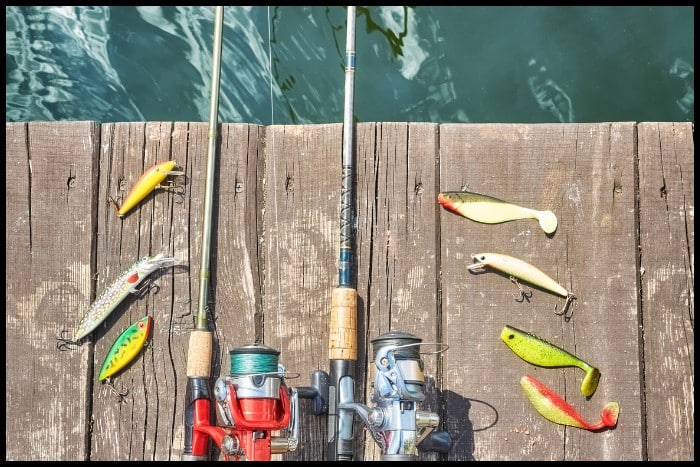
2. Ultra-lightweight Fishing Line
Trout have sharp eyesight and can be spooked easily by heavy fishing lines. Consider using a lightweight fishing line, such as a 2-6 pound test, for a more subtle presentation and better sensitivity.
Monofilament and fluorocarbon are the best lines to use for trout since they are clear and nearly invisible in light-pound tests.
However, the downside of using such a light line is you’ll need to be careful when reeling in the fish to avoid snapping the line, especially around sticks and rocks the trout can wrap around.
3. Lures and Live Bait
Trout are often selective about their food, so having a variety of lures and live bait options can increase your chances of success.
Some popular options include small spinners, spoons, soft plastic baits, live worms, crickets, and minnows. Trout are typically attracted to bright and flashy colors, including white, chartreuse, silver, and gold.
However, in certain conditions, you might find that dark-colored baits are getting more attention than light-colored baits. To be covered in all conditions, having some variety in your tackle box is essential.
4. A Landing Net
A landing net can be helpful for safely and quickly landing your catch, especially when fishing in fast-moving water or using lightweight tackle.
Look for a net with a soft, knotless mesh to reduce stress on the fish and minimize the risk of injury. Thanks to two key features, rubber nets are best for catch and release.
The first being the rubber material is soft on the small scales of the trout and will not damage them as knotted nets will.
The second reason is that hooks will not get stuck as easily as in soft materials, and this makes it easier to get the fish out.
5. Optional Gear
Other optional gears for trout fishing include waders or waterproof boots for fishing in streams or rivers, polarized sunglasses to reduce glare and improve visibility, and a fishing vest or backpack to carry all your gear and accessories.
Of course, a hat, snacks, water, sunscreen, or warm clothes are good to have based on the weather and how long you plan to be out. Plan your trips accordingly based on the weather, and stay safe out there.
A camera is great for getting pictures of the trout before you release them, or a knife to prep the fish to keep it and prepare it to cook.
A cooler with ice to keep the fish on after catching them is useful for taking them home.
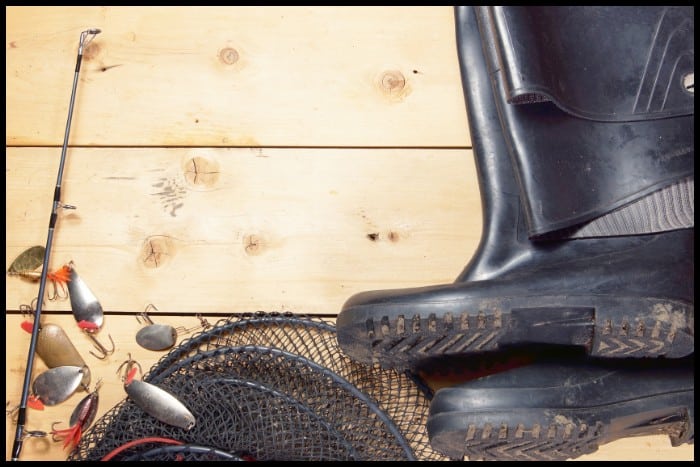
Best Lures and Techniques to Catch Trout
Some days while fishing for bass, bluegill, or other aggressive fish, it feels like any lure you throw in the water will get a bite.
Trout fishing, on the other hand, always feels like much more of a puzzle to find what they are feeding on.
1. Inline and Other Spinner Baits
Inline and other spinner baits are popular lures for trout fishing, as they create vibrations and flash in the water to attract hungry fish’s attention.
Here is my article on the best trout fishing baits for more info.
These lures can be effective in various water conditions, from slow-moving streams to fast-moving rivers.
These lures mimic bait fish and will trigger a reactionary bite from the trout, and can be incredibly effective, especially on wild trout.
2. Spoons
Spoons are another popular lure for trout fishing and can be especially effective when fishing in deeper waters or targeting larger fish.
These lures mimic the movement and flash of baitfish and can be fished using various techniques, such as trolling, jigging, or casting and retrieving.
Spoons are great for deep pools in rivers and lakes where you are trout fishing since you can let them fall to the desired depth and then begin retrieving them at a consistent pace.
Check out my lake trout fishing guide which will help you learn how to fish for trout in lakes specifically.
3. Soft Plastic Jigs
Soft plastic jigs, such as grubs and worms, can be effective for trout fishing, especially when targeting fish in slow-moving water or around structure.
These lures can be fished using various techniques, such as drifting, bouncing along the bottom, or slow and steady retrieves.
4. Artificial Eggs and Dough
Artificial eggs and dough baits can be effective for trout fishing, especially when targeting stocked fish that are used to feeding on these types of baits.
These baits can be fished using various techniques, such as drifting or bouncing along the bottom and can be especially effective when fishing in slower-moving water.
For trout fishing with any kind of live or artificial bait, hook sizes 8-14 are recommended based on the size of fish you target. And remember, the larger the number hook, the smaller it is.
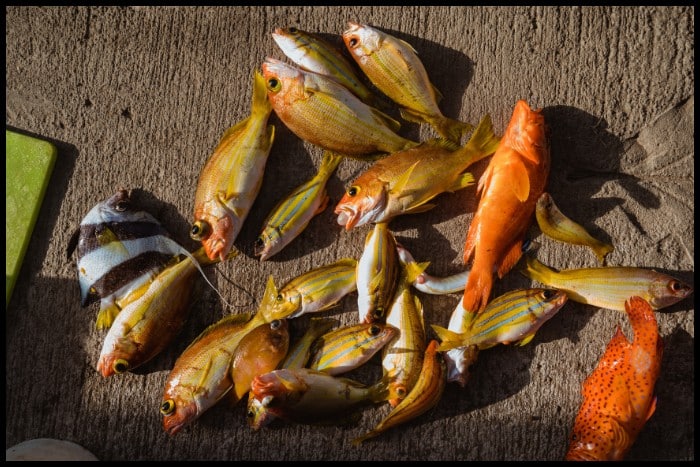
5. Live Baits
Live baits, such as worms, crickets, and minnows, can be effective for trout fishing, especially when targeting larger fish or fishing in moving water.
These baits can be fished using various techniques, such as drifting, casting, retrieving, or jigging.
Generally, live baits are what trout eat naturally rather than fish-mimicking lures, so you’ll get the best results with them.
Worms, mealworms, and scavenged baits near your fishing location will always work well.
6. Bonus Method: Fly Fishing
Fly fishing is a specialized technique involving lightweight lures, or flies, that imitate insects or other prey.
Fly fishing requires skill and practice but can be a highly effective and rewarding method for targeting trout, especially in clear, slow-moving water.
Popular flies for trout fishing include dry flies, nymphs, and streamers. Fly fishing might not be the most beginner-friendly method, but it’s one of the best ways to catch trout in any stream and river.
If you are looking for a unique fishing challenge, fly fishing is a good option.
Here are my fly fishing reel recommendations.
Other Tips For A Trout Fishing Beginner
If you are getting into trout fishing, even if you are experienced with other species, you might find a steep learning curve.
The tips below will help you with the beginning stages of learning about trout fishing and help you land the first few fish.
1. Trout Fishing Compared to Other Kinds of Fishing
While many types of fishing exist, trout fishing stands out in several ways, including the unique habitat and behavior of trout, the seasonal variations that affect fishing success, and the specialized techniques and equipment required to catch these elusive fish.
Bass, musky, walleye, and panfish can all be much more aggressive than trout, so an angler coming from them to trout might find it difficult to get a bite.
More finesse, patience, and a bit more luck might be necessary to start catching your first trout.
2. Stocked Trout Compared to Wild Trout
One important consideration for trout fishing is whether to fish for stocked trout or wild trout.
Stocked trout are fish that have been raised in a hatchery and released into a waterway for the purpose of recreational fishing.
Wild trout, on the other hand, are those that are born and raised in the wild, often in more remote and challenging environments.
The type of trout you fish for will depend on your preferences and the regulations in your area.
Stocked trout typically fall for brightly colored artificial eggs and dough baits since that is closely related to the foods they are fed at the hatchery.
Wild trout, on the other hand, are easily spooked but can be more aggressive hunters if you get the right lure in front of their mouths.
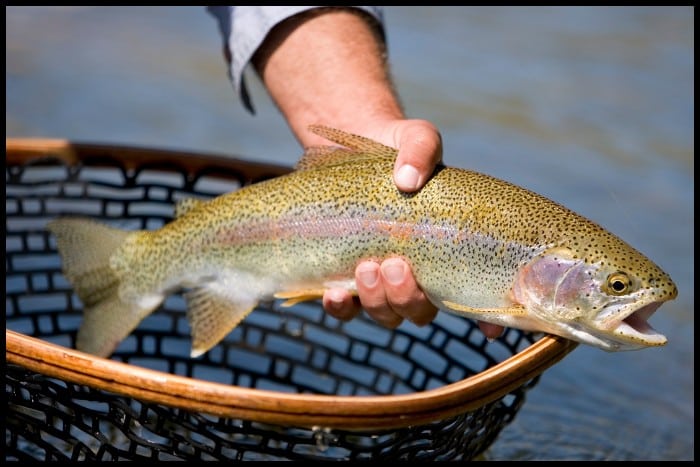
3. Choosing The Right Location
Another critical factor in successful trout fishing is choosing the right location. Trout require specific habitat conditions, such as clean, cold water with plenty of oxygen, cover, and food sources.
Some of the best locations for trout fishing include mountain streams, rivers, and lakes, which offer a variety of conditions and environments to explore.
I have a whole article for you on rainbow trout habitat for you to explore.
Stocking schedules released by local fish and wildlife organizations will let you know where and when stocked trout are released, and this is a great resource to follow.
Wild trout may require additional exploration and chatting with local fishermen to find the best areas.
4. Fish the Right Areas
Trout are often found in clear, cold, and fast-moving water, so focus your efforts on areas that meet these conditions, such as mountain streams, rivers, and high-altitude lakes.
Look for areas with structure, such as rocks or fallen trees, where trout can hide and ambush prey.
Look for deeper areas in the river along with breaks in the current behind rocks, at the edge of streams, and in eddies.
Lake trout will look for locations that provide both cover and food sources, so the best areas to fish are near water inlets if you can find them.
5. Be Patient
Trout can be elusive and challenging to catch, so be prepared to spend some time on the water and be patient.
Keep trying different techniques and lures until you find what works best for the conditions and the fish in the area.
You might not catch any trout on the first or second outing for new trout anglers, so be prepared to take these trips as learning experiences.
Practice different presentations, rigging techniques, and more in order to get the most from your time on the water.
6. Change Things Up
Don’t be afraid to change things up if you’re not having any luck with a particular lure or technique.
Try a different color or size of lure, fish in another area of the water, or adjust your retrieval speed or technique.
Some days the trout can be incredibly picky about the right lure and presentation, so you’ll need to try hundreds of retrieves to find the one that makes the fish bite.
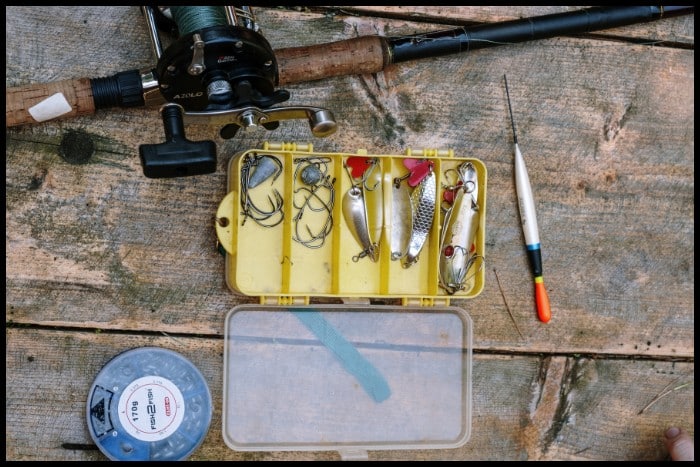
7. Use Colors Based On The Weather
The color of your lure can make a big difference in your success at catching trout. In general, use brighter colors on sunny days and darker colors on cloudy days.
Also, consider using natural colors that mimic the local baitfish and insects in the area. Changing the colors works so well due to the way the trout perceive the lures in the water.
When the weather is sunny and bright, flashy and bright-colored lures are easy to see and will grab the trout’s attention.
On cloudy days, darker-colored baits will create a silhouette that stands out even in hard-to-see conditions.
In clear water, natural colored baits do best since the fish will easily mistake them for bait fish native to their areas, and they can clearly see the colors and patterns of the fish.
8. Check Local Regulations
Before heading out to fish for trout, ensure you are familiar with the local fishing regulations.
These may include restrictions on the size and number of fish you can keep and rules about fishing methods and equipment.
Be sure to follow all regulations to ensure the long-term health and sustainability of the fishery.
Across the country, trout are one of the most regulated groups of fish, so you might find some strict regulations regarding baits, hooks, lures, bag limits, and more based on your specific area.
Educating yourself before you go will help keep natural fisheries intact for generations to come.
Conclusion
In conclusion, selecting the right trout fishing setup is critical for beginners looking to have a successful and enjoyable experience on the water.
Understanding the key components, including the rod, reel, line, and lures, can help beginners make informed decisions when purchasing equipment.
By following the tips and advice outlined in this article, novice anglers can feel confident and well-equipped to start their journey into the world of trout fishing.
Remember to always practice proper fishing techniques and respect the environment to ensure a sustainable future for our beloved fishing communities.
